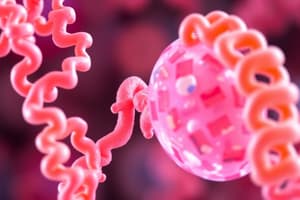Podcast
Questions and Answers
What is a nucleolus?
What is a nucleolus?
Structure in nucleus that is the site for ribosome synthesis.
What is a vesicle?
What is a vesicle?
Small, membrane-bound sac that functions in storage and transport within a cell.
What is a lysosome?
What is a lysosome?
Component of membrane-bound organelles that digests nutrients and cellular wastes.
How do the nucleus and ribosomes work together to produce proteins?
How do the nucleus and ribosomes work together to produce proteins?
What components are involved in the endomembrane system?
What components are involved in the endomembrane system?
What is magnification?
What is magnification?
What does resolution refer to in microscopy?
What does resolution refer to in microscopy?
What is a light microscope used for?
What is a light microscope used for?
What is an electron microscope used for?
What is an electron microscope used for?
What is cell theory?
What is cell theory?
What are bacteria and archaea?
What are bacteria and archaea?
What roles do the nucleus and ribosomes play in cells?
What roles do the nucleus and ribosomes play in cells?
What organelles are involved in the manufacture, distribution, and breakdown of molecules?
What organelles are involved in the manufacture, distribution, and breakdown of molecules?
What is the function of mitochondria and chloroplasts?
What is the function of mitochondria and chloroplasts?
What structures provide support and communication between cells?
What structures provide support and communication between cells?
What organelles are not found in plant cells?
What organelles are not found in plant cells?
What structures are found only in plant cells?
What structures are found only in plant cells?
What is the role of a lysosome?
What is the role of a lysosome?
What does a cell wall do?
What does a cell wall do?
What does the nucleus contain?
What does the nucleus contain?
What is the nuclear envelope?
What is the nuclear envelope?
What is chromatin?
What is chromatin?
What is a nucleolus?
What is a nucleolus?
What are peroxisomes?
What are peroxisomes?
What is rough ER associated with?
What is rough ER associated with?
What is smooth ER responsible for?
What is smooth ER responsible for?
What are the components of the cytoskeleton?
What are the components of the cytoskeleton?
What are ribosomes responsible for?
What are ribosomes responsible for?
What are free ribosomes?
What are free ribosomes?
What are bound ribosomes?
What are bound ribosomes?
What do both rough and smooth ER form?
What do both rough and smooth ER form?
What is the function of the Golgi apparatus?
What is the function of the Golgi apparatus?
Flashcards are hidden until you start studying
Study Notes
Cellular Structures and Functions
- Nucleolus: Located within the nucleus, responsible for ribosome synthesis.
- Vesicle: Membrane-bound sacs that serve in cellular storage and transport.
- Lysosome: Digestive organelle that breaks down nutrients and waste; not found in plant cells.
- Endomembrane System: Comprises the nuclear envelope, endoplasmic reticulum, Golgi apparatus, lysosomes, vacuoles, and plasma membrane, facilitating synthesis, storage, and transport of molecules.
Protein Synthesis Process
- Proteins are synthesized in ribosomes using mRNA transcribed from DNA in the nucleus, acting as instructional templates.
Microscopy Techniques
- Magnification: Involves increasing the apparent size of an object to assist in observation.
- Resolution: Refers to the clarity of an image, allowing distinction between two closely placed objects.
- Light Microscope: Best for viewing thin or transparent samples mounted on slides.
- Electron Microscope: Capable of examining opaque samples of varying thicknesses at higher resolutions.
Cell Theory
- Proposed by Schleiden, Schwann, and Virchow, asserting:
- All living things are composed of cells.
- Cells represent the basic unit of life.
- New cells arise from pre-existing cells.
Cell Types
- Bacteria and Archaea: Represent simpler prokaryotic cell structures.
- Eukaryotic Cells: Contain a nucleus and ribosomes, involved in cell's genetic control and protein synthesis.
Cellular Organelles
- Endoplasmic Reticulum: Contributes to the manufacture and transport of molecules; has rough (with ribosomes) and smooth (lipid synthesis) types.
- Golgi Apparatus: Acts as a processing and shipping center, receiving products from the ER and dispatching them for use or export.
- Mitochondria: Energy processing organelles found in all cells; chloroplasts are present exclusively in plant cells for photosynthesis.
Structural Components
- Cytoskeleton: Composed of microtubules, microfilaments, and intermediate filaments; provides structural support and facilitates movement.
- Plasma Membrane and Cell Wall: The plasma membrane regulates entry and exit of substances, while the cell wall found in plant cells offers protection and shape.
- Cell Wall: Forms a protective layer composed mainly of cellulose, which provides rigidity and contains plasmodesmata for intercellular communication.
Unique Organelles
- Lysosomes: Function as the cell's "garbage disposal," digesting cellular waste.
- Peroxisomes: Involved in metabolic processes, particularly waste management.
- Centrioles: Not present in plant cells, play a role in cell division.
Ribosomes
- Free Ribosomes: Reside in the cytoplasm, producing proteins that operate within the cytoplasm.
- Bound Ribosomes: Attached to the endoplasmic reticulum, synthesizing proteins destined for export from the cell.
Overall Functions
- Organelles work in harmony for the manufacture, distribution, and breakdown of biomolecules essential for cellular function.
Studying That Suits You
Use AI to generate personalized quizzes and flashcards to suit your learning preferences.




